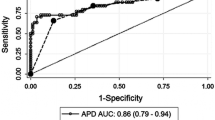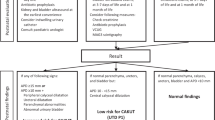Abstract
Antenatal hydronephrosis (ANH) is a frequent anomaly detected on fetal ultrasound scans. There is no consensus recommendation for the postnatal follow-up and/or the necessity to perform a voiding cystourethrography (VCUG) to diagnose vesicoureteral reflux (VUR). We conducted a cohort/non-randomized trial of 121 patients with ANH, defined as an anterior posterior diameter (APD) ≥5 mm after the 20th week of gestation, to evaluate the ability of the antenatal and postnatal ultrasonography results to predict VUR. All infants had two successive ultrasounds at 5 days and 1 month, respectively, after birth. A VCUG was performed at 6 weeks in children with a persistent APD ≥5 mm and/or an ureteral dilatation observed on at least one of two postnatal ultrasounds. In total, 88 patients had VCUG and nine had VUR, with five having high-grade reflux (>grade II). The risk of VUR increased significantly with the degree of APD detected on the postnatal ultrasound scan (p = 0.03). The odds ratios were 5.0 [95% confidence interval (CI) 0.5–51.2] for APD = 7–9 mm and 9.1 (95% CI 1.0–80.9) for APD ≥10 mm. The results of this study show that among our patient cohort antenatal ultrasound was not predictive of reflux. There was, however, a relation between the importance of the postnatal renal pelvis diameter and the risk of VUR. A cut-off of 7 mm showed a fair ability of ultrasonography to predict VUR and a cut-off of 10 mm enabled all severe refluxes in the 88 patients who had a VCUG to be diagnosed.

Similar content being viewed by others
Abbreviations
- APD:
-
anterior posterior diameter
- RPD:
-
renal pelvic dilatation
- UTI:
-
urinary tract infection
- VCUG:
-
voiding cystourethrography
- VUR:
-
vesicoureteral reflux
References
Roth JA, Diamond DA (2001) Prenatal hydronephrosis. Curr Opin Pediatr 13:138–141
Sairam S, Al-Habib A, Sasson S, Thilaganathan B (2001) Natural history of fetal hydronephrosis diagnosed on mid-trimester ultrasound. Ultrasound Obstet Gynecol 17:191–196
Grignon A, Filion R, Filiatrault D, Robitaille P, Homsy Y, Boutin H, Leblond R (1986) Urinary tract dilatation in utero: classification and clinical applications. Radiology 160:645–647
Corteville JE, Gray DL, Crane JP (1991) Congenital hydronephrosis: correlation of fetal ultrasonographic findings with infant outcome. Am J Obstet Gynecol 165:384–388
Lee RS, Cendron M, Kinnamon DD, Nguyen HT (2006) Antenatal hydronephrosis as a predictor of postnatal outcome: a meta-analysis. Pediatrics 118:586–593
Upadhyay J, McLorie GA, Bolduc S, Bagli DJ, Khoury AE, Farhat W (2003) Natural history of neonatal reflux associated with prenatal hydronephrosis: long-term results of a prospective study. J Urol 169:1837–1841, discussion 1841; author reply 1841
Farhat W, McLorie G, Geary D, Capolicchio G, Bagli D, Merguerian P, Khoury A (2000) The natural history of neonatal vesicoureteral reflux associated with antenatal hydronephrosis. J Urol 164:1057–1060
Ismaili K, Avni FE, Wissing KM, Hall M (2004) Long-term clinical outcome of infants with mild and moderate fetal pyelectasis: validation of neonatal ultrasound as a screening tool to detect significant nephrouropathies. J Pediatr 144:759–765
Ismaili K, Avni FE, Hall M (2002) Results of systematic voiding cystourethrography in infants with antenatally diagnosed renal pelvis dilation. J Pediatr 141:21–24
Malone PS (1996) Antenatal diagnosis of renal tract anomalies: has it increased the sum of human happiness? J R Soc Med 89:155P–158P
Marra G, Oppezzo C, Ardissino G, Dacco V, Testa S, Avolio L, Taioli E, Sereni F (2004) Severe vesicoureteral reflux and chronic renal failure: a condition peculiar to male gender? Data from the ItalKid Project. J Pediatr 144:677–681
Knudson MJ, Austin JC, McMillan ZM, Hawtrey CE, Cooper CS (2007) Predictive factors of early spontaneous resolution in children with primary vesicoureteral reflux. J Urol 178:1684–1688
Penido Silva JM, Oliveira EA, Diniz JS, Bouzada MC, Vergara RM, Souza BC (2006) Clinical course of prenatally detected primary vesicoureteral reflux. Pediatr Nephrol 21:86–91
Gonzalez E, Papazyan JP, Girardin E (2005) Impact of vesicoureteral reflux on the size of renal lesions after an episode of acute pyelonephritis. J Urol 173:571–574, discussion 574-575
Coplen DE, Austin PF, Yan Y, Dicke JM (2008) Correlation of prenatal and postnatal ultrasound findings with the incidence of vesicoureteral reflux in children with fetal renal pelvic dilatation. J Urol 180:1631–1634, discussion 1634
Wong DC, Anderson PA, Macken M, Jackson JR (1999) Congenital hydronephrosis who requires intervention? Can J Urol 6:812–818
Avni EF, Ayadi K, Rypens F, Hall M, Schulman CC (1997) Can careful ultrasound examination of the urinary tract exclude vesicoureteric reflux in the neonate? Br J Radiol 70:977–982
Lebowitz RL, Olbing H, Parkkulainen KV, Smellie JM, Tamminen-Mobius TE (1985) International system of radiographic grading of vesicoureteric reflux. International Reflux Study in Children. Pediatr Radiol 15:105–109
Sargent MA (2000) What is the normal prevalence of vesicoureteral reflux? Pediatr Radiol 30:587–593
Persutte WH, Koyle M, Lenke RR, Klas J, Ryan C, Hobbins JC (1997) Mild pyelectasis ascertained with prenatal ultrasonography is pediatrically significant. Ultrasound Obstet Gynecol 10:12–18
Phan V, Traubici J, Hershenfield B, Stephens D, Rosenblum ND, Geary DF (2003) Vesicoureteral reflux in infants with isolated antenatal hydronephrosis. Pediatr Nephrol 18:1224–1228
Estrada CR Jr (2008) Prenatal hydronephrosis: early evaluation. Curr Opin Urol 18:401–403
Parvex P, Willi JP, Kossovsky MP, Girardin E (2008) Longitudinal analyses of renal lesions due to acute pyelonephritis in children and their impact on renal growth. J Urol 180:2602–2606, discussion 2606
Kapadia H, Lidefelt KJ, Erasmie U, Pilo C (2004) Antenatal renal pelvis dilatation emphasizing vesicoureteric reflux: two-year follow-up of minor postnatal dilatation. Acta Paediatr 93:336–339
Anderson NG, Wright S, Abbott GD, Wells JE, Mogridge N (2003) Fetal renal pelvic dilatation—poor predictor of familial vesicoureteral reflux. Pediatr Nephrol 18:902–905
Walsh G, Dubbins PA (1996) Antenatal renal pelvis dilatation: a predictor of vesicoureteral reflux? AJR Am J Roentgenol 167:897–900
Persutte WH, Hussey M, Chyu J, Hobbins JC (2000) Striking findings concerning the variability in the measurement of the fetal renal collecting system. Ultrasound Obstet Gynecol 15:186–190
Wiener JS, O'Hara SM (2002) Optimal timing of initial postnatal ultrasonography in newborns with prenatal hydronephrosis. J Urol 168:1826–1829
Moorthy I, Joshi N, Cook JV, Warren M (2003) Antenatal hydronephrosis: negative predictive value of normal postnatal ultrasound—a 5-year study. Clin Radiol 58:964–970
Lidefelt KJ, Herthelius M, Soeria-Atmadja S (2009) Antenatal renal pelvis dilatation: 2-year follow-up with DMSA scintigraphy. Pediatr Nephrol 24:533–536
Acknowledgments
The authors acknowledge the contributions of Mrs. Cécile Delhumeau, who provided assistance with the statistical aspects of our study and Dr. Eric Antonelli who transmitted the antenatal data.
The authors have indicated they have no financial relationships or conflict of interest relevant to this article to disclose.
Author information
Authors and Affiliations
Corresponding author
Rights and permissions
About this article
Cite this article
Grazioli, S., Parvex, P., Merlini, L. et al. Antenatal and postnatal ultrasound in the evaluation of the risk of vesicoureteral reflux. Pediatr Nephrol 25, 1687–1692 (2010). https://doi.org/10.1007/s00467-010-1543-9
Received:
Revised:
Accepted:
Published:
Issue Date:
DOI: https://doi.org/10.1007/s00467-010-1543-9




